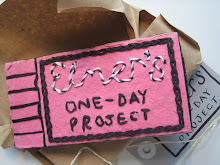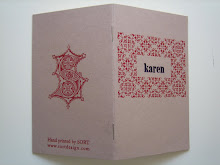I've been meaning to do a write-up of a seminar I chaired at the ICA earlier this month in association with MA Poetic Practice, but I've been putting it off as my transcript is sketchy with a lot of gaps. The seminar entitled, The Idea as Book : The Book as Idea, took place on the 14th of July and looked to interrogate the artist’s book in relation to ideas of conceptual art and concrete poetry. It was part of a series of events tying in with the current exhibition Poor. Old. Tired. Horse. which takes an imaginative and expansive look at text-based art practices from the 1960s to the present day.
The aims of the seminar were to explore the limitations and the potential of artists’ books with regards to the book as space, the book as self-reflexive, the book as performance and the book as process. It drew upon past and present examples of book art, conceptual art and concrete poetry in order to foreground the ever deepening cross-over between these art forms. Members of the panel included Redell Olsen, Allen Fisher, Mark Pawson, Elizabeth James and Kate Gallon.
The following was discussed: "Space" as public and private and the 2D/3D relationship between a work and how you view it. The social formations thought to be missing from the show. Typewriter works looking old-fashioned yet possessing a nostalgic quality. Redell Olsen referred to Lilian Lijn's 3D sculpture, Sky Never Stops, as a type of book, a "cone book" in fact. Like a book it invites the viewer to read it but in a way that requires the viewer to be aware of his/her own physical presence as well as the presence of the moving cone. Both object and viewer are moving and participating. We talked about books not only referencing spaces/sites but via their materiality they can very much hold a site too. I guess an example of this would be Dieter Roth's Daily Mirror. The "preciousness" of the art object was also brought up and in particular the issue of allowing artists' books to be handled. Suggestions about their display and distribution were also made. Ed Ruscha's Information Man was mentioned but I can't remember in what context.
If I were to take one thing away from it, it would be the concept of space in relation to the book, that is, the book as an object made up of pockets of space as well as the book as an object occupying a space. Some did say that they didn't think it useful to discuss the book and space, but I'm interested in Ulises Carrión's play with space in relation to the book. It's potential is limitless and that's not just in conceptual terms but in actual physical terms. How people choose to use the book is obviously interesting as is the space in which it is made and then stored or displayed. During the discussion Allen Fisher pointed out Carrión's book Tell me what sort of wall paper your room has and I will tell you who you are, a book that comprises of a selection of wallpaper pieces with labels such as 'Living Room', 'Bedroom' and 'My Friend's Room' overprinted onto each page. Each page references an external space collated into the space of one book. Carrión moves you from space to space / place to place, each individualised as the reader turns the page and feels the uniqueness of the textured wallpaper. I think it's important to bring up Carrión's work as concrete and visual poetry did play a part in his break with literature in a more traditional sense. He also emphasised the close relationship between poetry and artists' books, insisting that poets were responsible for opening up the way to such bookworks.
A big thanks to the panel and everyone who came and to those who helped and read and re-read my list of questions just days before the event.
The aims of the seminar were to explore the limitations and the potential of artists’ books with regards to the book as space, the book as self-reflexive, the book as performance and the book as process. It drew upon past and present examples of book art, conceptual art and concrete poetry in order to foreground the ever deepening cross-over between these art forms. Members of the panel included Redell Olsen, Allen Fisher, Mark Pawson, Elizabeth James and Kate Gallon.
The following was discussed: "Space" as public and private and the 2D/3D relationship between a work and how you view it. The social formations thought to be missing from the show. Typewriter works looking old-fashioned yet possessing a nostalgic quality. Redell Olsen referred to Lilian Lijn's 3D sculpture, Sky Never Stops, as a type of book, a "cone book" in fact. Like a book it invites the viewer to read it but in a way that requires the viewer to be aware of his/her own physical presence as well as the presence of the moving cone. Both object and viewer are moving and participating. We talked about books not only referencing spaces/sites but via their materiality they can very much hold a site too. I guess an example of this would be Dieter Roth's Daily Mirror. The "preciousness" of the art object was also brought up and in particular the issue of allowing artists' books to be handled. Suggestions about their display and distribution were also made. Ed Ruscha's Information Man was mentioned but I can't remember in what context.
If I were to take one thing away from it, it would be the concept of space in relation to the book, that is, the book as an object made up of pockets of space as well as the book as an object occupying a space. Some did say that they didn't think it useful to discuss the book and space, but I'm interested in Ulises Carrión's play with space in relation to the book. It's potential is limitless and that's not just in conceptual terms but in actual physical terms. How people choose to use the book is obviously interesting as is the space in which it is made and then stored or displayed. During the discussion Allen Fisher pointed out Carrión's book Tell me what sort of wall paper your room has and I will tell you who you are, a book that comprises of a selection of wallpaper pieces with labels such as 'Living Room', 'Bedroom' and 'My Friend's Room' overprinted onto each page. Each page references an external space collated into the space of one book. Carrión moves you from space to space / place to place, each individualised as the reader turns the page and feels the uniqueness of the textured wallpaper. I think it's important to bring up Carrión's work as concrete and visual poetry did play a part in his break with literature in a more traditional sense. He also emphasised the close relationship between poetry and artists' books, insisting that poets were responsible for opening up the way to such bookworks.
A big thanks to the panel and everyone who came and to those who helped and read and re-read my list of questions just days before the event.









![five [yellow] poems](https://blogger.googleusercontent.com/img/b/R29vZ2xl/AVvXsEj7pWNS6-0OLKnVlSKvxNZqflLcymygEpr7SKNZ6DxOw2ujEBwCNVmJyjSNWrwfRduPucxM75xqy150M74MeXwHdLaK8OEy3vX-qNnWPPAj4JQiJA_hiqwlqGsxHqQ9Lzf4ANVHutXo7jRQ/s220/book2.JPG)














